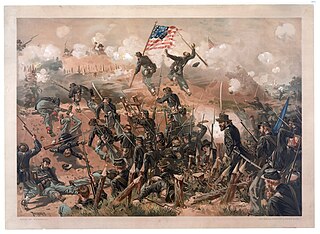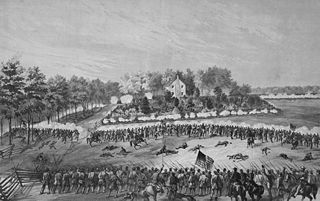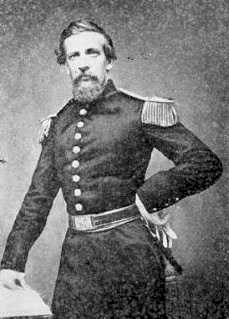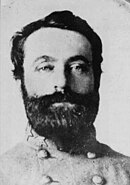
The Battle of Shiloh, also known as the Battle of Pittsburg Landing, was a major battle in the American Civil War fought on April 6–7, 1862. The fighting took place in southwestern Tennessee, which was part of the war's Western Theater. The battlefield is located between a small, undistinguished church named Shiloh and Pittsburg Landing on the Tennessee River. Two Union armies combined to defeat the Confederate Army of Mississippi. Major General Ulysses S. Grant was the Union commander, while General Albert Sidney Johnston was the Confederate commander until his battlefield death, when he was replaced by his second-in-command, General P. G. T. Beauregard.

The siege of Vicksburg was the final major military action in the Vicksburg campaign of the American Civil War. In a series of maneuvers, Union Major General Ulysses S. Grant and his Army of the Tennessee crossed the Mississippi River and drove the Confederate Army of Mississippi, led by Lieutenant General John C. Pemberton, into the defensive lines surrounding the fortress city of Vicksburg, Mississippi, leading to the successful siege and Confederate surrender.

The Battle of Arkansas Post, also known as Battle of Fort Hindman, was fought from January 9 to 11, 1863, near the mouth of the Arkansas River at Arkansas Post, Arkansas, as part of the Vicksburg Campaign of the American Civil War. Confederate forces had constructed a fort known as Fort Hindman near Arkansas Post in late 1862. In December of that year, a Union force under the command of Major-General William T. Sherman left for an expedition against Vicksburg, without Major-General John A. McClernand because neither Major-Generals Henry Halleck nor Ulysses S. Grant trusted McClernand. After Sherman's force was repulsed at Chickasaw Bayou, McClernand arrived and took command from Sherman in January 1863.

The Vicksburg campaign was a series of maneuvers and battles in the Western Theater of the American Civil War directed against Vicksburg, Mississippi, a fortress city that dominated the last Confederate-controlled section of the Mississippi River. The Union Army of the Tennessee under Major General Ulysses S. Grant gained control of the river by capturing this stronghold and defeating Lieutenant General John C. Pemberton's forces stationed there.

The Battle of Jackson was fought on May 14, 1863, in Jackson, Mississippi, as part of the Vicksburg campaign during the American Civil War. After entering the state of Mississippi in late April 1863, Major General Ulysses S. Grant of the Union Army moved his force inland to strike at the strategic Mississippi River town of Vicksburg, Mississippi. The Battle of Raymond, which was fought on May 12, convinced Grant that General Joseph E. Johnston's Confederate army was too strong to be safely bypassed, so he sent two corps, under Major Generals James B. McPherson and William T. Sherman, to capture Johnston's position at Jackson. Johnston did not believe the city was defensible and began withdrawing. Brigadier General John Gregg was tasked with commanding the Confederate rear guard, which fought Sherman's and McPherson's men at Jackson on May 14 before withdrawing. After taking the city, Union troops destroyed economic and military infrastructure and also plundered civilians' homes. Grant then moved against Vicksburg, which he placed under siege on May 18 and captured on July 4. Despite being reinforced, Johnston made only a weak effort to save the Vicksburg garrison, and was driven out of Jackson a second time in mid-July.

John Alexander McClernand was an American lawyer and politician, and a Union Army general in the American Civil War. He was a prominent Democratic politician in Illinois and a member of the United States House of Representatives before the war. McClernand was firmly dedicated to the principles of Jacksonian democracy and supported the Compromise of 1850.
XIII Corps was a corps of the Union Army during the American Civil War. It was first led by Ulysses S. Grant and later by John A. McClernand and Edward O.C. Ord. It served in the Western Theater of civil war, Trans-Mississippi Theater and along the Gulf of Mexico.

The Battle of Champion Hill of May 16, 1863, was the pivotal battle in the Vicksburg Campaign of the American Civil War (1861–1865). Union Army commander Maj. Gen. Ulysses S. Grant and the Army of the Tennessee pursued the retreating Confederate States Army under Lt. Gen. John C. Pemberton and defeated it twenty miles to the east of Vicksburg, Mississippi, leading inevitably to the siege of Vicksburg and surrender. The battle is also known as Baker's Creek.

The Battle of Big Black River Bridge was fought on May 17, 1863, as part of the Vicksburg Campaign of the American Civil War. After a Union army commanded by Major General Ulysses S. Grant defeated Lieutenant General John C. Pemberton's Confederate army at the Battle of Champion Hill on May 16, Pemberton ordered Brigadier General John S. Bowen to hold a rear guard at the crossing of the Big Black River to buy time for the Confederate army to regroup. Union troops commanded by Major General John McClernand pursued the Confederates, and encountered Bowen's rear guard. A Union charge quickly broke the Confederate position, and during the retreat and river crossing, a rout ensued.

The Battle of Chickasaw Bayou, also called the Battle of Walnut Hills, fought December 26–29, 1862, was the opening engagement of the Vicksburg Campaign during the American Civil War. Confederate forces under Lt. Gen. John C. Pemberton repulsed an advance by Union Maj. Gen. William T. Sherman that was intended to lead to the capture of Vicksburg, Mississippi.

The Battle of Raymond was fought on May 12, 1863, near Raymond, Mississippi, during the Vicksburg campaign of the American Civil War. Initial Union attempts to capture the strategically important Mississippi River city of Vicksburg failed. Beginning in late April 1863, Union Major General Ulysses S. Grant led another try. After crossing the river into Mississippi and winning the Battle of Port Gibson, Grant began moving east, intending to turn back west and attack Vicksburg. A portion of Grant's army consisting of Major General James B. McPherson's 10,000 to 12,000-man XVII Corps moved northeast towards Raymond. The Confederate commander of Vicksburg, Lieutenant General John C. Pemberton, ordered Brigadier General John Gregg and his 3,000 to 4,000-strong brigade from Jackson to Raymond.

The Battle of Grand Gulf was fought on April 29, 1863, during the American Civil War. Union Army forces commanded by Major General Ulysses S. Grant had failed several times to bypass or capture the Confederate-held city of Vicksburg, Mississippi, during the Vicksburg campaign. Grant decided to move his army south of Vicksburg, cross the Mississippi River, and then advance on the city. A Confederate division under Brigadier General John S. Bowen prepared defenses—Forts Wade and Cobun—at Grand Gulf, Mississippi, south of Vicksburg. To clear the way for a Union crossing, seven Union Navy ironclad warships from the Mississippi Squadron commanded by Admiral David Dixon Porter bombarded the Confederate defenses at Grand Gulf on April 29. Union fire silenced Fort Wade and killed its commander, but the overall Confederate position held. Grant decided to cross the river elsewhere.

The Battle of Snyder's Bluff was fought from April 29 to May 1, 1863, during the Vicksburg Campaign of the American Civil War. Federal Major General Ulysses S. Grant had decided to move most of his army down the west bank of the Mississippi River and then cross south of Vicksburg, Mississippi, at Grand Gulf as part of his campaign against the city. To cover his planned crossing, Major General William T. Sherman took Francis P. Blair Jr.'s division of his XV Corps on a maneuver up the Yazoo River to feint at Confederate defenses at Snyder's Bluff and Drumgould's Bluff.

John Stevens Bowen was a career United States Army officer who later became a general in the Confederate Army and a commander in the Western Theater of the American Civil War. He fought at the battles of Shiloh, Corinth, and the Vicksburg Campaign. He is often said to have died just as his abilities were gaining attention.

The following Confederate Army units and commanders fought in the Battle of Raymond; the Union order of battle is listed separately.
The Jackson expedition, preceding and related to the siege of Jackson immediately followed the Confederate surrender of Vicksburg, Mississippi on July 4, 1863 to Union Army Major General Ulysses S. Grant commanding the Union Army of the Tennessee. The Confederate Army of Mississippi at Vicksburg, under the command of Lieutenant General John C. Pemberton, had been isolated in the Vicksburg defenses by Grant's forces since May 18, 1863. The Confederates were under constant artillery bombardment, had to fight off a series of Union Army attacks and could not receive supplies of food and ammunition during the siege.

Friend Smith Rutherford was a colonel in the Union Army during the American Civil War. He commanded the 97th Illinois Infantry Regiment during the Vicksburg campaign. On June 18, 1864, President Abraham Lincoln nominated Rutherford for appointment to the grade of brigadier general of volunteers and the United States Senate confirmed the appointment on June 28, 1864. Rutherford's appointment was dated June 27, 1864, and it was to rank from June 28, 1864. His appointment was made and commission issued without knowledge of his death on June 20, 1864. Since Rutherford had died, the confirmation technically could not be given and the commission could not become effective. Nonetheless, several sources list Rutherford as a Union Army general, although historian Ezra Warner does not.

Landis's Missouri Battery, also known as Landis's Company, Missouri Light Artillery, was an artillery battery that served in the Confederate States Army during the early stages of the American Civil War. The battery was formed when Captain John C. Landis recruited men from the Missouri State Guard in late 1861 and early 1862. The battery fielded two 12-pounder Napoleon field guns and two 24-pounder howitzers for much of its existence, and had a highest reported numerical strength of 62 men. After initially serving in the Trans-Mississippi Theater, where it may have fought in the Battle of Pea Ridge, the unit was transferred east of the Mississippi River. The battery saw limited action in 1862 at the Battle of Iuka and at the Second Battle of Corinth.
The 3rd Missouri Infantry Regiment served in the Confederate States Army during the American Civil War. The infantry regiment was officially mustered into service on January 17, 1862. It fought at the Battle of Pea Ridge in Arkansas in March before being transferred across the Mississippi River. While stationed at Corinth, Mississippi, the regiment played a minor role in the Battle of Farmington before the evacuation of the town. In September, the unit saw light action at the Battle of Iuka before being heavily engaged during the Second Battle of Corinth as the Confederates attempted to retake the town in October. In early 1863, the regiment was transferred to Grand Gulf, Mississippi, in order to strengthen the defenses of the Mississippi River at that point. At the Battle of Grand Gulf on April 29, the unit helped repulse a Union Navy attack against the Confederate defensive works. After elements of the Union Army of the Tennessee landed below Grand Gulf, the regiment fought in a delaying action at the Battle of Port Gibson on May 1.

Steele's Greenville expedition took place from April 2 to 25, 1863, during the Vicksburg campaign of the American Civil War. Union forces commanded by Major General Frederick Steele occupied Greenville, Mississippi, and operated in the surrounding area, to divert Confederate attention from a more important movement made in Louisiana by Major General John A. McClernand's corps. Minor skirmishing between the two sides occurred, particularly in the early stages of the expedition. Over 1,000 slaves were freed during the operation, and large quantities of supplies and animals were destroyed or removed from the area. Along with other operations, including Grierson's Raid, Steele's Greenville expedition distracted Confederate attention from McClernand's movement. Some historians have suggested that the Greenville expedition represented Union war policy shifting more towards expanding the war to Confederate social and economic structures and the Confederate homefront.


























